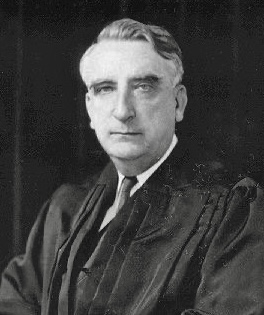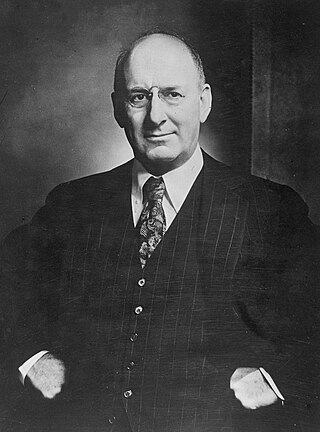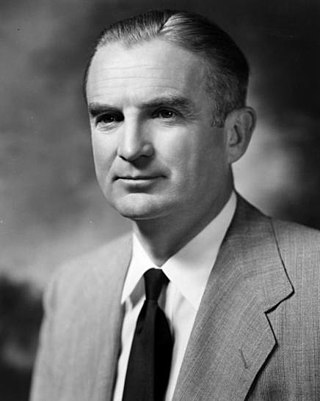Related Research Articles
The Reconstruction Finance Corporation (RFC) was a government corporation administered by the United States Federal Government between 1932 and 1957 that provided financial support to state and local governments and made loans to banks, railroads, mortgage associations, and other businesses. Its purpose was to boost the country's confidence and help banks resume daily functions after the start of the Great Depression. The RFC became more prominent under the New Deal and continued to operate through World War II. It was disbanded in 1957, when the US Federal Government concluded that it no longer needed to stimulate lending.

Henry Agard Wallace was an American politician, journalist, farmer, and businessman who served as the 33rd vice president of the United States, from 1941 to 1945, under President Franklin D. Roosevelt. He served as the 11th U.S. secretary of agriculture and the 10th U.S. secretary of commerce. He was the nominee of the new Progressive Party in the 1948 presidential election.
This section of the timeline of United States history concerns events from 1930 to 1949.
The Fair Deal was a set of proposals put forward by U.S. President Harry S. Truman to Congress in 1945 and in his January 1949 State of the Union address. More generally, the term characterizes the entire domestic agenda of the Truman administration, from 1945 to 1953. It offered new proposals to continue New Deal liberalism, but with a conservative coalition controlling Congress, only a few of its major initiatives became law and then only if they had considerable Republican Party support. As Richard Neustadt concludes, the most important proposals were aid to education, national health insurance, the Fair Employment Practices Commission, and repeal of the Taft–Hartley Act. They were all debated at length, then voted down. Nevertheless, enough smaller and less controversial items passed that liberals could claim some success.

Frederick "Fred" Moore Vinson was an American attorney and politician who served as the 13th chief justice of the United States from 1946 until his death in 1953. Vinson was one of the few Americans to have served in all three branches of the U.S. government. Before becoming chief justice, Vinson served as a U.S. Representative from Kentucky from 1924 to 1928 and 1930 to 1938, as a federal appellate judge on the U.S. Court of Appeals for the District of Columbia Circuit from 1938 to 1943, and as the U.S. Secretary of the Treasury from 1945 to 1946.

Henry Morgenthau Jr. was the United States Secretary of the Treasury during most of the administration of Franklin D. Roosevelt. He played a major role in designing and financing the New Deal. After 1937, while still in charge of the Treasury, he played the central role in financing United States participation in World War II. He also played an increasingly major role in shaping foreign policy, especially with respect to Lend-Lease, support for China, helping Jewish refugees, and proposing measures to deindustrialise Germany.

William Stuart Symington III was an American businessman and Democratic politician from Missouri. He served as the first Secretary of the Air Force from 1947 to 1950 and was a United States Senator from Missouri from 1953 to 1976.
The United States maintained its Constitutional Republic government structure throughout World War II. Certain expediencies were taken within the existing structure of the Federal government, such as conscription and other violations of civil liberties, including the internment and later dispersal of Japanese-Americans. Still, elections were held as scheduled in 1944.

The 79th United States Congress was a meeting of the legislative branch of the United States federal government, composed of the United States Senate and the United States House of Representatives. It met in Washington, D.C., from January 3, 1945, to January 3, 1947, during the last months of Franklin D. Roosevelt's presidency, and the first two years of Harry Truman's presidency. The apportionment of seats in this House of Representatives was based on the 1940 United States census.

Guy Mark Gillette was an American politician serving as a Democratic U.S. Representative and Senator from Iowa. In the U.S. Senate, Gillette was elected, re-elected, defeated, elected again, and defeated again.

The Truman Committee, formally known as the Senate Special Committee to Investigate the National Defense Program, was a United States Congressional investigative body, headed by Senator Harry S. Truman. The bipartisan special committee was formed in March 1941 to find and correct problems in US war production with waste, inefficiency, and war profiteering. The Truman Committee proved to be one of the most successful investigative efforts ever mounted by the U.S. government: an initial budget of $15,000 was expanded over three years to $360,000 to save an estimated $10–15 billion in military spending and thousands of lives of U.S. servicemen. For comparison, the entire cost of the simultaneous Manhattan Project, which created the first atomic bombs, was $2 billion. Chairing the committee helped Truman make a name for himself beyond his political machine origins and was a major factor in the decision to nominate him as vice president, which would propel him to the presidency after the death of Franklin D. Roosevelt.

Harry S. Truman was an American politician who served as the 33rd president of the United States from 1945 to 1953. A member of the Democratic Party, he previously served as a United States senator from Missouri from 1935 to 1945 and briefly as the 34th vice president in 1945 under Franklin D. Roosevelt. Assuming the presidency after Roosevelt's death, Truman implemented the Marshall Plan in the wake of World War II to rebuild the economy of Western Europe and established both the Truman Doctrine and NATO to contain the expansion of Soviet communism. He proposed numerous liberal domestic reforms, but few were enacted by the conservative coalition that dominated the Congress.
The Surplus Property Act of 1944 is an act of the United States Congress that was enacted to provide for the disposal of surplus government property to "a State, political subdivision of a State, or tax-supported organization". It authorized a three-member board, known as the Surplus Property Board, a structure that was replaced within a year by an agency run by a single administrator. Many of its provisions were repealed on July 1, 1949.
The War Assets Administration (WAA) was created to dispose of United States government-owned surplus material and property from World War II. The WAA was established in the Office for Emergency Management, effective March 25, 1946, by Executive Order 9689, January 31, 1946. It was headed by Robert McGowan Littlejohn.

Harry S. Truman's tenure as the 33rd president of the United States began on April 12, 1945, upon the death of president Franklin D. Roosevelt, and ended on January 20, 1953. He had been vice president for only 82 days when he succeeded to the presidency. Truman, a Democrat from Missouri, ran for and won a full four-year term in the 1948 presidential election, in which he narrowly defeated Republican nominee Thomas E. Dewey and Dixiecrat nominee Strom Thurmond. Although exempted from the newly ratified Twenty-second Amendment, Truman did not run for a second full term in the 1952 presidential election because of his low popularity. He was succeeded by Republican Dwight D. Eisenhower.
The Federal Works Agency (FWA) was an independent agency of the federal government of the United States which administered a number of public construction, building maintenance, and public works relief functions and laws from 1939 to 1949. Along with the Federal Security Agency and Federal Loan Agency, it was one of three catch-all agencies of the federal government pursuant to reorganization plans authorized by the Reorganization Act of 1939, the first major, planned reorganization of the executive branch of the government of the United States since 1787.
The National War Labor Board, commonly the War Labor Board, was an independent agency of the United States government, established January 12, 1942, by an executive order of President Franklin D. Roosevelt, the purpose of which was to mediate labor disputes as part of the American home front during World War II.
The presidency of Harry S. Truman began on April 12, 1945, when Harry S. Truman became the 33rd president upon the death of Franklin D. Roosevelt, and ended on January 20, 1953.

The third presidential term of Franklin D. Roosevelt began on January 20, 1941, when he was once again inaugurated as the 32nd president of the United States, and the fourth term of his presidency ended with his death on April 12, 1945. Roosevelt won a third term by defeating Republican nominee Wendell Willkie in the 1940 United States presidential election. He remains the only president to serve for more than two terms. Unlike his first two terms, Roosevelt's third and fourth terms were dominated by foreign policy concerns, as the United States became involved in World War II in December 1941.

Fulbright Act of 1946, 50a U.S.C. § 1619, is a United States statute commissioning the United States Department of State as a disposal agency for the disposal of materials on public lands and the reclamation of salvageable military surplus assets pending the aftermath of World War II. The Act of Congress was an amendment to the Surplus Property Act of 1944 implementing section 1619 entitled designation of disposal agencies.
References
- ↑ ”Surplus Property: Uncle Sam, Merchant,” Time Magazine, 1945-06-23.
- ↑ 58 Stat. 768.
- 1 2 Editorial, "Surplus Property," Life Magazine, 1944-12-18 at p. 20
- ↑ Phillips J. Beck, "Baruch Offers Plan to Take Government 'Out' of Business," Connellsville (PA) Daily Courier, 1944-02-21 at p. 5.
- ↑ Franklin D. Roosevelt, "Executive Order 9425 Establishing the Surplus War Property Administration," February 19, 1944, reprinted at The American Presidency Project website, last accessed 2010-08-01.
- 1 2 U.S. at War: The Surplus Surplus Bill, 1944-10-02, Time Magazine.
- 1 2 3 Editorial, “Year’s Delay on War Surplus Disposal,” Waterloo (IA) Daily Courier, 1945-09-18 at p. 4.
- ↑ ”Statement on Signing the Surplus Property Act of 1944.,” October 3, 1944, reprinted at The American Presidency Project website, last accessed 2010-07-28.
- 1 2 3 Records of the War Assets Administration (WAA) in the holdings of the US National Archives and Records Administration.
- 1 2 Harold Stein, “Public Administration and Policy Development,” 321 (Harcourt, Brace: 1952).
- 1 2 "Stormy Weather," Time Magazine, 1944-12-04.
- ↑ ”Surplus Property Board Formed,” Hamilton (OH) Daily News Journal, 1944-11-22 at 1.
- ↑ "Lieut. Colonel Edward Hellman Heller, Time Magazine)".
- ↑ "Inside Washington," Valparaiso Vidette-Messenger, 1945-04-16 at p. 7.
- 1 2 "Under the Capitol Dome," Ames Daily Tribune, 1945-07-20 at p. 4.
- ↑ ”Transcript of President Truman's News Conference,” June 7, 1945, reprinted at The American Presidency Project website, last accessed 2010-07-29.
- 1 2 3 ”Special Message to the Congress on Amending the Surplus Property Act To Provide for a Single Administrator,” July 17, 1945, reprinted at The American Presidency Project website, last accessed 2010-07-28.
- 1 2 ”War Leftovers to Aid U.S. Business, SPB Says,” Abilene (TX) Reporter-News, 1945-09-13 at p. 10.
- ↑ 59 Stat. 533, codified at 50 U.S.C. §§ 1612, 1614a, 1614b, 1615 to 1621, 1623 to 1630; repealed June 30, 1949, ch. 288, title VI, § 602(a)(1).